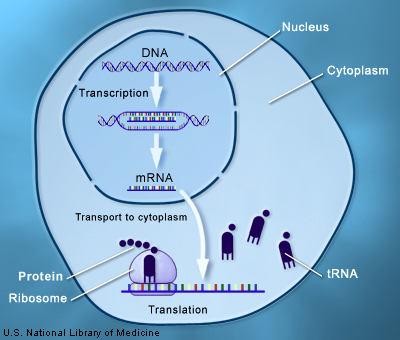 |
||
| A service of the U.S. National Library of Medicine® | ||
How does a gene make a protein?Most genes contain the information needed to make functional molecules called proteins. (A few genes produce other molecules that help the cell assemble proteins.) The journey from gene to protein is complex and tightly controlled within each cell. It consists of two major steps: transcription and translation. Together, transcription and translation are known as gene expression. During the process of transcription, the information stored in a gene's DNA is transferred to a similar molecule called RNA (ribonucleic acid) in the cell nucleus. Both RNA and DNA are made up of a chain of nucleotide bases, but they have slightly different chemical properties. The type of RNA that contains the information for making a protein is called messenger RNA (mRNA) because it carries the information, or message, from the DNA out of the nucleus into the cytoplasm. Translation, the second step in getting from a gene to a protein, takes place in the cytoplasm. The mRNA interacts with a specialized complex called a ribosome, which "reads" the sequence of mRNA bases. Each sequence of three bases, called a codon, usually codes for one particular amino acid. (Amino acids are the building blocks of proteins.) A type of RNA called transfer RNA (tRNA) assembles the protein, one amino acid at a time. Protein assembly continues until the ribosome encounters a “stop” codon (a sequence of three bases that does not code for an amino acid). The flow of information from DNA to RNA to proteins is one of the fundamental principles of molecular biology. It is so important that it is sometimes called the “central dogma.”  Through the processes of transcription and translation, information from genes is used to make proteins.
For more information about making proteins:For a more detailed description of transcription and translation, please refer to the section “From Genes to Proteins: Start to Finish” in the NCBI Science Next Topic: Can genes be turned on and off in cells? Previous Topic: What are proteins and what do they do? |



 Indicates a page outside Genetics Home Reference.
Indicates a page outside Genetics Home Reference.